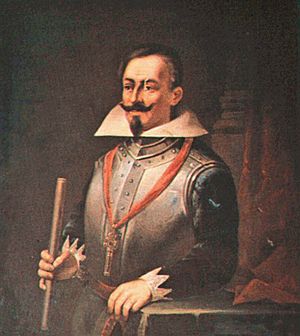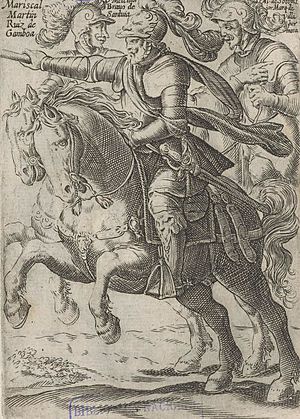Alonso de Sotomayor facts for kids
Quick facts for kids
Don
Alonso de Sotomayor
|
|
|---|---|
 |
|
| Royal Governor of Chile | |
| In office 1583–1592 |
|
| Monarch | King Philip II |
| Preceded by | Martín Ruiz de Gamboa |
| Succeeded by | Pedro de Viscarra |
| Royal Governor of Panama | |
| In office 1596–1602 |
|
| Monarch | King Philip II |
| Preceded by | Juan del Barrio |
| Succeeded by | Hernando de Añazco |
| Personal details | |
| Born | c. 1545 Trujillo, Spain |
| Died | 1610 (aged 64–65) Spain |
Alonso de Sotomayor y Valmediano (1545–1610) was a Spanish soldier and explorer, also known as a conquistador. He came from Extremadura, a region in Spain. He later became a Royal Governor of Chile, which meant he was the king's main representative and leader in that area.
Contents
Early Life and Military Career
Alonso de Sotomayor was born in Trujillo, a town in Spain, around 1545. His parents were Gutiérrez de Sotomayor e Hinojosa and Beatriz de Valmediano. When he was just 15 years old, he joined the army.
He served as a soldier in Italy until 1567. After that, he moved to Flanders, a region in Europe, where he continued his military service. In 1580, he was called back to Madrid, the capital of Spain. King Philip II was impressed by his military experience. The King made Sotomayor a knight in the Order of Santiago, a special group of knights.
Around this time, news arrived from Chile about a long-running conflict called the Arauco War. More soldiers were urgently needed there. Because of his strong military background, King Philip II decided to name Sotomayor as the new governor of Chile. He sent him with many soldiers to help solve the problems in the region.
Governor of Chile
Alonso de Sotomayor arrived in Chile in 1583. His first big task was to act like a judge. He had to listen to many complaints against the previous governor, Martín Ruiz de Gamboa. Gamboa had become very unpopular because of a tax system he put in place. This system, called the Tasa de Gamboa, stopped Native Americans from paying taxes with their labor.
Sotomayor had to arrest and imprison Gamboa for a short time. However, Sotomayor later decided to clear Gamboa of the charges and set him free. Sotomayor's first major decision as governor was to bring back an older system of labor taxes. He got rid of the Tasa de Gamboa and brought back the Tasa de Santillán. He tried to make this older system fairer to prevent people in charge from being too harsh on the Native Americans.
The Arauco War and Forts
Sotomayor wanted to expand the Spanish control in Chile, similar to how Pedro de Valdivia had done it. His idea was to build many forts that would protect each other and the Spanish cities. However, to do this, he needed a large, professional army. He asked the Spanish leaders for more soldiers, but they said no. There weren't enough resources in the area or money from the King to send more troops.
Instead, Sotomayor led several campaigns against the Mapuche people, who were resisting Spanish rule. He managed to capture Alonso Díaz, a leader of the Mapuche resistance for many years. Sotomayor also sent his brother, Luis, to fight in the area around Valdivia. They successfully defeated the Mapuches in a surprise attack at Angol on January 16, 1585.
Sotomayor also started building his forts, even with the few men he had. In 1584, he built the fort of San Fabián de Conueo. In 1585, he ordered the building of the fort Santo Arbol de la Cruz. He also built forts on both sides of the Bio Bio River, called Espíritu Santo and Santísima Trinidad. Another fort was built at San Jerónimo de Millapoa, and a small group of soldiers was placed at Purén.
He built these forts to cut off communication among the Mapuche people. He hoped that towns would quickly grow around these forts, bringing more people and soldiers to Chile. He believed this was the best way to finally bring the tribes under Spanish control.
However, Mapuche leaders like Nongoniel, Cadeguala, and Guanoalca fought against these forts. They eventually forced the Spanish to leave Purén in 1586. In 1589, Sotomayor took back and expanded the fort of Purén. He also built a fort near the sea at Marihueñu. In 1590, he moved the town of Arauco to its current location closer to the sea.
Despite his efforts, Sotomayor's actions did not truly weaken the Mapuche people. Capturing Díaz didn't change the overall situation. The forts also didn't have the big impact he hoped for. Instead, the Mapuche people became better at using Spanish horses and weapons. Their main challenge was the arquebus, an old type of gun, because they didn't know how to use it and couldn't get gunpowder.
Other Challenges as Governor
While dealing with the Mapuche resistance, Sotomayor also faced attacks from English pirates. The most famous pirate was Thomas Cavendish, who arrived in Quintero on April 9, 1587. However, the Spanish defeated him there, and he lost 10 men.
Sotomayor also had to deal with soldiers in the south who rebelled. They were very poor because they weren't being paid in gold or land rights. Worried about the situation and the lack of new soldiers, Sotomayor went to Peru on July 30, 1592. He hoped to ask the king's representative there, called the viceroy, for more men. He left an experienced lawyer named Pedro de Viscarra in charge of Chile.
Governor of Panama
In August, Sotomayor arrived in Callao, Peru. There, he learned that the king had already named a new governor for Chile, Martín García Óñez de Loyola. Sotomayor returned to Chile to explain and defend his actions as governor. He was successful in proving he had done a good job.
He then started his journey back to Spain. But on the way, the Viceroy of Peru stopped him. The viceroy asked Sotomayor to take charge of the province of Panama. Panama was in danger of an English invasion at that time. Sotomayor accepted and served as Governor of Panama from 1596 to 1602.
Later Life
After his time in Panama, Alonso de Sotomayor returned to Spain. In 1604, he was again offered the position of governor of Chile. However, because of the difficult experiences he had there before, he decided to turn down the job. He joined the Council of the Indies, an important group that advised the king on matters related to the Spanish colonies.
Images for kids
-
Alonso de Ovalle's 1646 engraving of Ruiz de Gamboa, Bravo de Saravia and Sotomayor
See also
 In Spanish: Alonso de Sotomayor y Valmediano para niños
In Spanish: Alonso de Sotomayor y Valmediano para niños
| Government offices
|
||
|---|---|---|
| Preceded by Martín Ruiz de Gamboa |
Royal Governor of Chile 1583–1592 |
Succeeded by Pedro de Viscarra |
| Preceded by Juan del Barrio |
Royal Governor of Panama 1596–1602 |
Succeeded by Hernando de Añazco |



